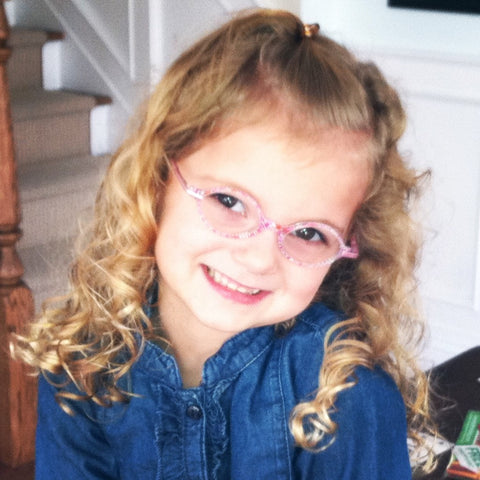
Ella Jane in her first pair of glasses.
Universal truth #1: Nobody likes exams—not academic exams, not medical exams—that’s why the thought of your child’s first eye exam can be just as daunting for you as it is for them. What if you forget something? What if they misbehave? What if you don’t really know what to expect? Thankfully, we’ve been through enough eye exams to last a lifetime, and hope that by sharing our experiences, and helping you and your child to prepare, the whole process may seem a little less scary, and dare we say, even fun? OK, maybe not fun…
THE BASICS
Whether you already have a cause for concern over your child’s vision—e.g. a failed screening at the pediatrician—or you’re just eager to get their vision checked, the fundamentals of a first eye exam are the same. Most appointments last over an hour, but prepare for several just in case. Making sure that your child has everything they need (snacks, diapers, toys) will immediately relieve some of the stress associated with waiting around.
THE PREP - a few days/weeks before
Try introducing the concept of an eye exam to your child gradually over the days and weeks preceding the appointment. The more they become comfortable with the concept of looking at eye charts, having someone look at their eyes and using eye drops, the more likely they are to be comfortable at the appointment. Create a game by having them name shapes and colors (if they are old enough) from various distances. You may even want to prepare them for the eye drops by practicing on a stuffed animal beforehand or by trying some child-safe eye drops on them.
THE DETAILS - a few days before
There’s always a lot to remember for your child’s medical appointments and an eye exam is no exception. In addition to everything you’ll need to keep them happy and not-hungry, you’ll also need to bring a list of medications that they are currently taking, a history of any vision problems in the family, and a list of questions you have for the doctor (along with a pen and paper to note down their replies). We’ve found that it’s always better, if possible, to have two adults at the eye exam—one to keep the child occupied and another to talk directly to the doctor.
THE PROCESS - the day of
At the doctor’s office, your child will be given dilating eye drops in order to better examine the shape and structure of the eye. You’ll both have to wait around while the drops take effect and they may sting a little (but this is only temporary). We also recommend bringing some sunglasses along for after the appointment in case your child’s eyes feel sensitive.
The doctor is going to be checking how healthy your child’s eyes are, how well they can see and how well the eyes are working together. A well-versed pediatric eye doctor will have numerous ways of determining your child’s vision, including but not limited to charts, tests and close examination. While none of these procedures hurt, it’s normal for your child to be resistant and nervous, so just make sure you’re there to comfort and distract them along the way.
Above all, when the mystery is taken out of an eye exam, and you and your child feel prepared, you’ll quickly realize that there is nothing at all to worry about. Once the exam is over, you and your child’s doctor can prepare a treatment plan (if necessary) to make sure your child’s vision is the very best it can be! Next time, we’ll walk you through the process of finding out your child does, in fact, need glasses and what to do…